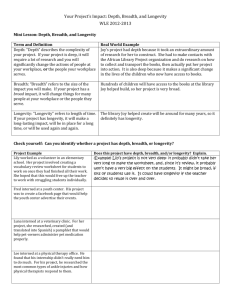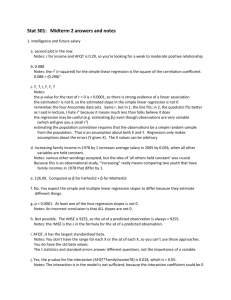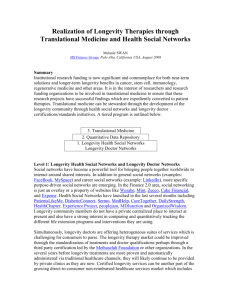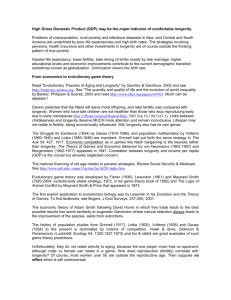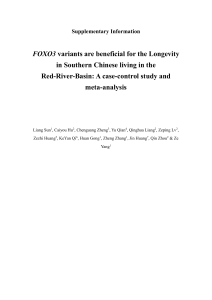HR301_Longevity - Core-CT
advertisement
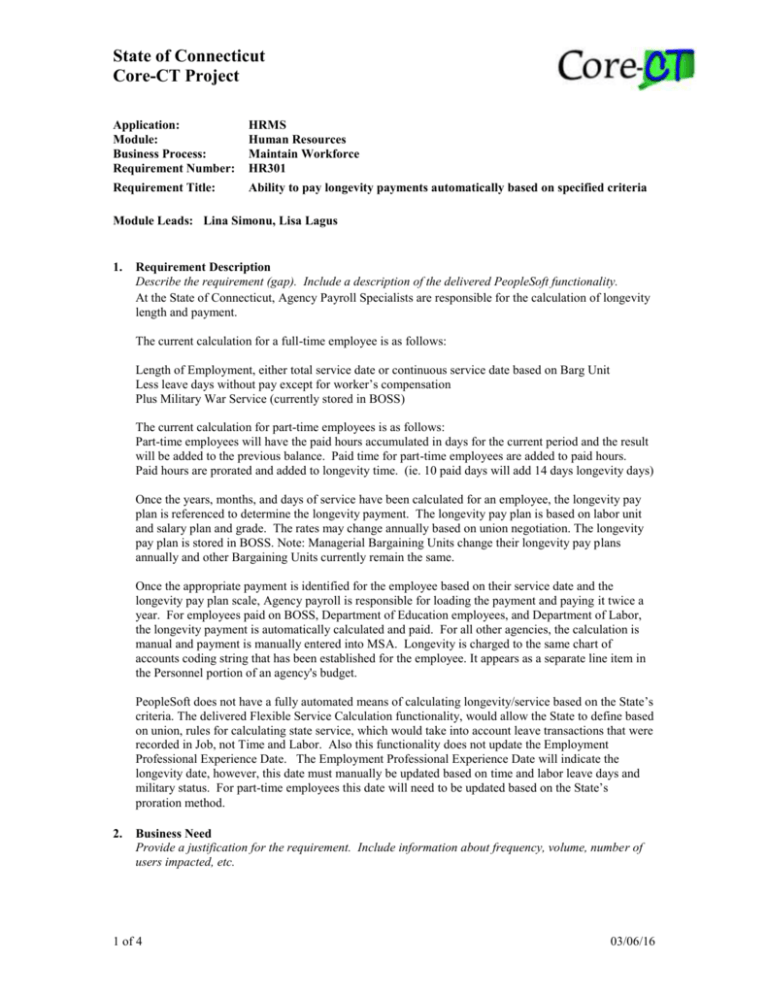
State of Connecticut Core-CT Project Application: Module: Business Process: Requirement Number: HRMS Human Resources Maintain Workforce HR301 Requirement Title: Ability to pay longevity payments automatically based on specified criteria Module Leads: Lina Simonu, Lisa Lagus 1. Requirement Description Describe the requirement (gap). Include a description of the delivered PeopleSoft functionality. At the State of Connecticut, Agency Payroll Specialists are responsible for the calculation of longevity length and payment. The current calculation for a full-time employee is as follows: Length of Employment, either total service date or continuous service date based on Barg Unit Less leave days without pay except for worker’s compensation Plus Military War Service (currently stored in BOSS) The current calculation for part-time employees is as follows: Part-time employees will have the paid hours accumulated in days for the current period and the result will be added to the previous balance. Paid time for part-time employees are added to paid hours. Paid hours are prorated and added to longevity time. (ie. 10 paid days will add 14 days longevity days) Once the years, months, and days of service have been calculated for an employee, the longevity pay plan is referenced to determine the longevity payment. The longevity pay plan is based on labor unit and salary plan and grade. The rates may change annually based on union negotiation. The longevity pay plan is stored in BOSS. Note: Managerial Bargaining Units change their longevity pay plans annually and other Bargaining Units currently remain the same. Once the appropriate payment is identified for the employee based on their service date and the longevity pay plan scale, Agency payroll is responsible for loading the payment and paying it twice a year. For employees paid on BOSS, Department of Education employees, and Department of Labor, the longevity payment is automatically calculated and paid. For all other agencies, the calculation is manual and payment is manually entered into MSA. Longevity is charged to the same chart of accounts coding string that has been established for the employee. It appears as a separate line item in the Personnel portion of an agency's budget. PeopleSoft does not have a fully automated means of calculating longevity/service based on the State’s criteria. The delivered Flexible Service Calculation functionality, would allow the State to define based on union, rules for calculating state service, which would take into account leave transactions that were recorded in Job, not Time and Labor. Also this functionality does not update the Employment Professional Experience Date. The Employment Professional Experience Date will indicate the longevity date, however, this date must manually be updated based on time and labor leave days and military status. For part-time employees this date will need to be updated based on the State’s proration method. 2. Business Need Provide a justification for the requirement. Include information about frequency, volume, number of users impacted, etc. 1 of 4 03/06/16 State of Connecticut Core-CT Project During April 2001, 31,221 longevity checks were issued to State of Connecticut employees. Payments are made semi-annually for approximately 31,000 employees. All Agency Payroll Specialists are responsible for ensuring payments are made accurately and in a timely manner. 3. Required By: (Y/N) Federal ____ State Statutory ____ Agency ____ State Regulatory ____ Bargaining Unit _Y___ State Procedural _Y___ 4. Requirement Priority __High___ (High, Medium, Low – please see “Requirements Prioritization Criteria”) 5. Recommended Solution Enter an “X” next to the appropriate category ______ __ Process Solution Option Number ___X___ _1__ Application Modification Option Number 6. Explanation for Recommendation Provide reasons for recommendation. Please do not re-state the description of the solution itself. Longevity payments are required to be paid to employees on a semi-annual basis. There is an existing automated process for employees on the BOSS TAS system. Without this modification, the State’s current level of service would be reduced and payments for longevity would need to be calculated and administered manually within Core-CT. 7. Organizational Impact of Recommendation Describe the changes to the organization that result from the recommended solution. Include a description of any role, process, statute, or bargaining unit agreement affected. 8. The Central Salary Specialist would need to maintain the new custom longevity interval and rate table. The Agency HR Specialist would need to maintain the Employment Service Date online for a break in service due to leave based on bargaining unit rules. They would also be required to run and review the custom agency longevity report to ensure the appropriate payment was made to employees in their agency. Process Solutions Describe the possible Process Solutions. Include a description of impacts and benefits of each solution. Option 1. Manually determine the longevity date and enter the payment. 1) Run a pre-defined query to select employees that were on leave without pay based on their Job record for all bargaining units. 2) Run a pre-defined query to determine the number of leave days without pay during the specified period based on the TRC’s reported for each employee eligible for longevity payment. These TRC’s and TRC types need to be identified during configuration. 3) Determine the years, months, and days of Military Service and type of service based on the Military Service Start and End dates. 2 of 4 03/06/16 State of Connecticut Core-CT Project 4) Manually update the Employment Professional Experience Date based on the Job Leave and the number of leave days without pay recorded in TL. 5) Add the employee’s military service, but do not update the Employment Professional Experience Date based on this information. (This will be recalculated every six months, so the military service will not be included to ensure it is not counted more than once.) 6) Review a hard copy of the longevity pay plan for each union and determine the payment amount based on the employee’s service. 7) Manually enter the longevity amount with the appropriate earnings code into the Additional Pay pages. 8) A pre-defined query by agency is produced listing each employee, longevity payment amount, and earnings code for the specified pay period. 9) A pre-defined query needs to be produced to identify any employees that have a longevity payment greater than or equal to $6,000. This would be run by Central Payroll to ensure these payments are not made to employees. Notes on Option 1: Conversion of the Employment Professional Experience Date upon implementation has calculated the service date based on the current legacy calculation and used either the legacy continuous service date or total service date based on union association. Therefore the leave days without pay except for Voluntary Leave after 6/9/94 through the implementation date will be included in the converted service date. Military Service needs to be added to the service date each time longevity is calculated, as this information is not effective dated. If the service is added, and then military service changes, it may be overlooked or added more than once. 9. Application Modifications Describe the possible Application Modifications. Include a description of impacts and benefits of each solution. Option 1. Modification Type (On-line, Batch, Interface, Report, Workflow): Batch Complexity (Easy, Medium, Difficult): Difficult Description: 1) Create a Longevity Rate Table for each Salary Plan with the appropriate intervals of service, and payment at each interval. Currently, the intervals of service occur every 5 years. This table will be effective date to maintain history as rates are renegotiated. 2) Add the Military Service Start and End Dates and the Military Service Type fields to the Education and Government Personal Data record and page for entry of this information for employees upon hire. This is a separate requirement (See HR104). 3) Manually adjust the Employment Professional Experience Date online for a break in service due to leave without pay. 4) Create a batch program that will be executed semi-annually by salary plan/bargaining unit. The program will calculate the new Employment Professional Experience Date based on the current Employment Professional Experience date, less the number of leave days without pay during the specified period based on the TRC’s reported for each employee through time and labor. The Employment Professional Experience Date is then updated on the Employment record. Then the calculated Military Service is added to the new Employment Professional Experience Date, however, this is not updated on the Employment record. Then based on the new Employment Service Date plus military service, the program determines the longevity payment amount based on the new Longevity Rate Table. A record is inserted into the Additional Pay record for the effective date of the payment, with the longevity earnings code and the appropriate earnings amount for each employee. The Additional 3 of 4 03/06/16 State of Connecticut Core-CT Project Pay goal amount should also be set to equal the earnings amount to ensure the payment is not made more than once. 6) Create a new custom report by agency that lists each employee, longevity payment amount, and earnings code for the specified pay period. 7) A pre-defined query needs to be produced to identify any employees that have a longevity payment greater than or equal to $6,000. This would be run by Central Payroll to ensure these payments are not made to employees. Option 2. Modification Type (On-line, Batch, Interface, Report, Workflow): Batch Complexity (Easy, Medium, Difficult): Difficult Description: Use the delivered Compensation Rate Code Seniority Pay functionality to determine the Longevity interval and corresponding amount based on the Company Seniority Date. The Company Seniority Date would need to be manually updated based on the number of leave days in time and labor and the military service date. Each State employee would need to be setup in a PeopleSoft Longevity Group based on their Salary Plan and union. A compensation rate code for each salary plan would need to be configured based on union salary longevity rules. When the delivered Update Seniority Pay (CMP013) and Update Seniority Eligibility (CMP014) application engine and database agent processes are run for a specified Group, the seniority payment is applied to their compensation record, which may be viewed or updated online on the Job Data Compensation page. As delivered, there are several known issues with these programs logged on PeopleSoft Customer Connection, such as the processes run for employees outside of the Group specified and do not exclude terminated and retired employees. Also, the State’s longevity payment is paid out at a different frequency than the base pay, ie.) semi-annually, and should be paid in the pay period the Update Seniority Pay and Update Seniority Eligibility processes are run. Payment should be made with a longevity earnings code for reporting purposes and not be lumped into the employee’s regular earnings code as all other compensation rate components of pay are paid. These programs would need to be modified as they do not meet all of the State’s requirements and have known issues as delivered. Create a new custom report by agency that lists each employee, longevity payment amount, and earnings code for the specified pay period. A pre-defined query also needs to be produced to identify any employees that have a longevity payment greater than or equal to $6,000. This would be run by Central Payroll to ensure these payments are not made to employees. 4 of 4 03/06/16
